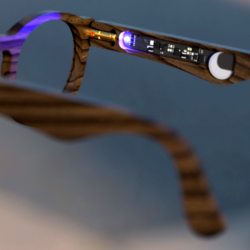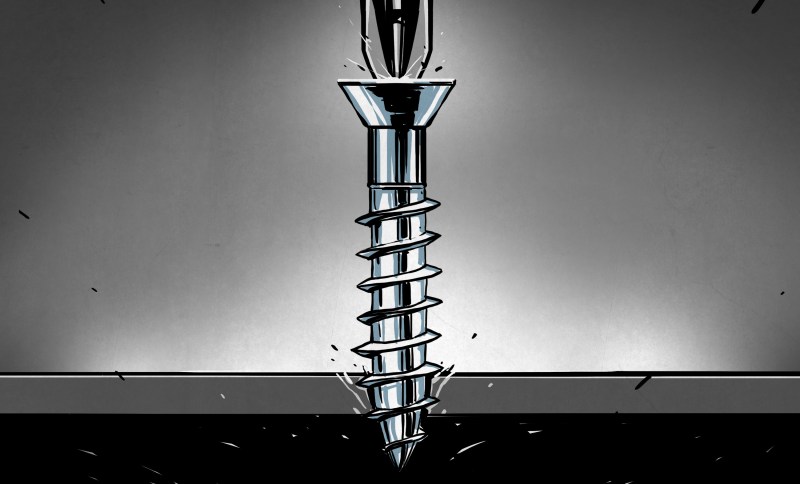Mike and I were talking about an interesting smart-glasses hack on the podcast. This was one of those projects where, even if you don’t need a pair of glasses with LEDs on them to help you navigate around, you just couldn’t help but marvel at a lot of the little design choices made throughout.
For instance, I love the way the flex PCB is made to do double duty by wrapping around the battery and forming a battery holder. This struck me as one of those quintessential hacks that only occurs to you because you need it. Necessity is the mother of invention, and all that. There was a problem, how to fit a battery holder in the tiny space, and a set of resources that included a flex PCB substrate. Cleverly mashing that all together ended up with a novel solution. This wouldn’t occur to you if you were just sitting at the beach; you’d have to be designing something electronic, space-constrained, and on a flex PCB to come up with this.
 Mike made an offhand comment about how sometimes you just need to finish a project for the good ideas and clever solutions that you’ll come up with along the way, and I think this battery holder example drives that point home. I can’t count the number of my projects that may or may not have been dumb in retrospect, but along the way I came up with a little trick that I’ll end up using in many further projects, outliving the original application.
Mike made an offhand comment about how sometimes you just need to finish a project for the good ideas and clever solutions that you’ll come up with along the way, and I think this battery holder example drives that point home. I can’t count the number of my projects that may or may not have been dumb in retrospect, but along the way I came up with a little trick that I’ll end up using in many further projects, outliving the original application.
Finishing up a project on principle is a reasonable goal just on its own. But when the process of seeing something to conclusion is the generator of new and interesting challenges and solutions, it’s even more valuable. So if you’re stuck on a project, and not sure you want to take it all the way, consider if the journey itself could be the destination, and look at it as an opportunity to come up with that next long-lasting trick.
Bad News: Arecibo
If you read the newsletter last week, you heard me wondering aloud if the damage to Arecibo Observatory had crossed the threshold into where it’s no longer economically viable to keep it running, and the sad news has just come in and the battle for Arecibo has been lost. We said we’d shed a tear, and here we are. Sic transit gloria mundi. Here’s hoping something cooler replaces it!
















Can someone help me understand what point this comment was making? I can’t find one.
🙌
No, sorry. It does seem more like a drunken ramble than an article.
The point of the comment could hardly be clearer and so it is reasonable to assume pure snarkiness on your part. Might I suggest that you consider the importance of staying above the fray.
Would it be extrapolating too much to assume stressful time behind the scenes? Step back, smell the roses, take a bit of a break perhaps.
I think the general point was the whole “It’s the journey, not the destination” idea. I love building complicated, impractical projects, but I almost never use them once they’re done. I’ve built mechanical computers and mechanical bit-mapped displays, along with things like a functioning Cray J90 wristwatch (it tells the time with an accurate n-body simulation of Jupiter and 63 of its moons!) – none of that stuff is useful in its own right, but going through the exercise of *actually* solving all the problems needs to bring an idea to fruition leaves you with a great skill set that can come in handy when you *do* actually care about the end product.
Also, RIP Arecibo =(
I didn’t think that Jupiter had 63 moons.
But apparently, after looking it up, there is 79 known “moons” orbiting around Jupiter.
Though, considering that the 4 largest moons makes up a total of 99.997% of all the mass of all 79 “moons”, then it is questionable if those other 75 “moons” are actually large enough to be considered a moon, and not just a rock that has found itself in orbit.
I for one wouldn’t regard each individual rock floating about in Saturn’s rings as individual moons.
Though, where to put the line between a tiny orbiting rock and a moon is a good question. Not that there is much of a limit in the other direction either…
A Cray J90 has 64-entry vector registers, so I went with Jupiter and the first 63 of its moons that were discovered. Through careful use of the vector instructions, I was able to fit the entire n-body simulator in slightly less than 128 instructions =)
…. wat? That’s pretty amazing! I probably couldn’t even do that if I somehow had a 5 terahertz CPU!
“Real artists ship.” – Steve Jobs
If it’s stupid but it works, it isn’t stupid.
Unless there’s a better solution that you didn’t have at hand because you were trying to put something together, while lacking the experience and skills to do it properly in the first place. Solving a problem you caused yourself isn’t exactly being smart.
That’s what differentiates hacking from engineering.
Not to mention all those times one sees some cobbled together solution that “works”, but is far from elegant and frankly abhorrent.
Worse is when it is the status quo within its field….
For what little experience I have, hacks tend to percolate down into production when the management is cheap and won’t pay to re-engineer the thing properly. Instead, they take the proof of concept and say, “Well, this works! Just do it like that.”
I sincerely hope you never visit a mechanic in these cutthroat “cheapest service in town/city” days.
Combination of cheapskate customers not willing to pay for getting the job done right, and franchises/chains owners trying to maximize profit has in general made it hell for those striving to do it right.
In my experience, that tends to be the case as well…
One reason prototyping on breadboards is nice, since it works, but can’t be sold as a final product.
Sadly, it can be hard to make a sufficient prototype on a breadboard at times.
I’ve seen the flexible PCB material wrapping around a battery before though, sort of… remember those battery testers that were built in to the packaging of batteries in the 90s? Not the ones actually on the batteries, but built into the polycarbonate vacuform package. They had a sort of flex PCB with like a printed conductive ink and some progressive resistance. When the battery was placed in there it would heat the strip progressively along its length and show the condition of the cell using thermochromic ink. A simple but effective and occasionally useful sales gimmick.
It was only good at showing whether the battery was dead or not, because any amount of heating would quickly color the whole strip as the heat spread around.
You could in theory make a non-linear resistor, but since the thermochromic ink would have a fixed cut-off temperature, you could not control what the strip would show to any degree of accuracy. 1-2 C difference in room temperature could mean the difference in showing 20% or 80% on the bar.
That said, how you actually would read the strip was by judging how fast it would turn from black to yellow. A fresh battery would do it instantly, and a tired old battery would take its time.
Only if the battery was truly dead, would you see it reach half way up the strip.
Yep, it was a gimmick to sell the batteries. But as gimmicks go, it wasn’t completely useless and it did involve wrapping a PCB of a sort around a battery…
One thing was how hard you had to press the strip to make it work. I remember it was literally painful.
I try to finish things by being very careful about what I start in the first place, so I don’t just build a lot of garbage.
IIRC, an article in Electronics Now described how to turn one into a power meter (for hams?).
I’m going to finish, just as soon as
… no carrier?
https://www.youtube.com/watch?v=eYHmKHqmRjE
finishing projects is not my strong suit. sometimes i get to a point and
… and learn to quit when you are ahead.
Basically this. I like hackaday but I’ll exclude it if they keep publishing Facebook posts like this. Terrible.
I recently finished a project I knew was going straight in the scrap heap when completed, just to say I had actually finihsed it. It was part of a collaboration, and the other party walked away. The pile of parts was eating at me, especially during lockdown. It has now been scrapped as expected but the sense of completion means I don’t feel any stress about it anymore.
Sometimes you just need to finish something to get it out of your head. Sometimes you need to realise you will never get round to finishing it and walk away. It’s a personal thing I think.
I never finish anyth
I don’t fret much about unfinished projects any-more. Some of them might never get completed, some I decided just weren’t worth the continued debugging/rework and I moved on. So was it worth doing at all? You bet it was! Those projects taught me so much about analog/opamp design, PCB design, noise filtering and other major aspects of design/debugging that the skills and experience will live on in future projects for the rest of my life!
… and hopefully those projects do get finished. Hopefully…